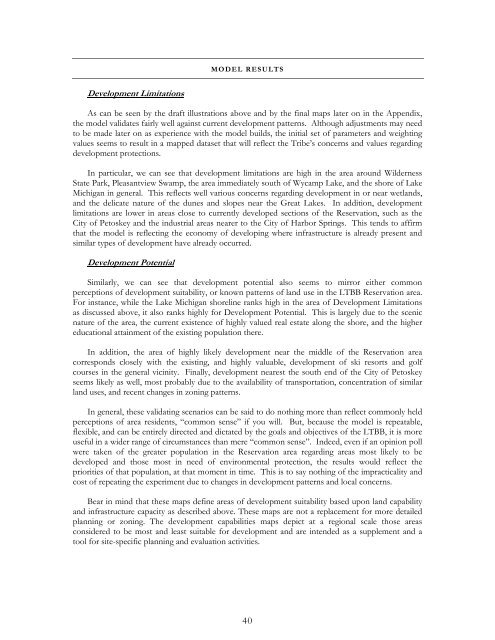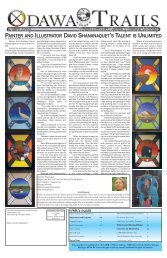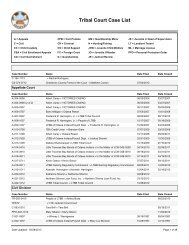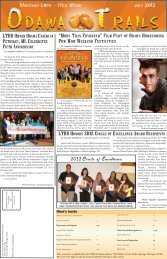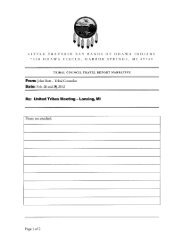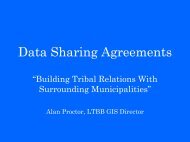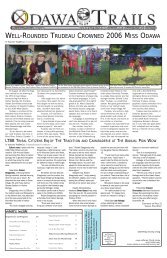LTBB Master Land Use Plan - Little Traverse Bay Bands of Odawa ...
LTBB Master Land Use Plan - Little Traverse Bay Bands of Odawa ...
LTBB Master Land Use Plan - Little Traverse Bay Bands of Odawa ...
You also want an ePaper? Increase the reach of your titles
YUMPU automatically turns print PDFs into web optimized ePapers that Google loves.
Development Limitations<br />
MODEL RESULTS<br />
As can be seen by the draft illustrations above and by the final maps later on in the Appendix,<br />
the model validates fairly well against current development patterns. Although adjustments may need<br />
to be made later on as experience with the model builds, the initial set <strong>of</strong> parameters and weighting<br />
values seems to result in a mapped dataset that will reflect the Tribe’s concerns and values regarding<br />
development protections.<br />
In particular, we can see that development limitations are high in the area around Wilderness<br />
State Park, Pleasantview Swamp, the area immediately south <strong>of</strong> Wycamp Lake, and the shore <strong>of</strong> Lake<br />
Michigan in general. This reflects well various concerns regarding development in or near wetlands,<br />
and the delicate nature <strong>of</strong> the dunes and slopes near the Great Lakes. In addition, development<br />
limitations are lower in areas close to currently developed sections <strong>of</strong> the Reservation, such as the<br />
City <strong>of</strong> Petoskey and the industrial areas nearer to the City <strong>of</strong> Harbor Springs. This tends to affirm<br />
that the model is reflecting the economy <strong>of</strong> developing where infrastructure is already present and<br />
similar types <strong>of</strong> development have already occurred.<br />
Development Potential<br />
Similarly, we can see that development potential also seems to mirror either common<br />
perceptions <strong>of</strong> development suitability, or known patterns <strong>of</strong> land use in the <strong>LTBB</strong> Reservation area.<br />
For instance, while the Lake Michigan shoreline ranks high in the area <strong>of</strong> Development Limitations<br />
as discussed above, it also ranks highly for Development Potential. This is largely due to the scenic<br />
nature <strong>of</strong> the area, the current existence <strong>of</strong> highly valued real estate along the shore, and the higher<br />
educational attainment <strong>of</strong> the existing population there.<br />
In addition, the area <strong>of</strong> highly likely development near the middle <strong>of</strong> the Reservation area<br />
corresponds closely with the existing, and highly valuable, development <strong>of</strong> ski resorts and golf<br />
courses in the general vicinity. Finally, development nearest the south end <strong>of</strong> the City <strong>of</strong> Petoskey<br />
seems likely as well, most probably due to the availability <strong>of</strong> transportation, concentration <strong>of</strong> similar<br />
land uses, and recent changes in zoning patterns.<br />
In general, these validating scenarios can be said to do nothing more than reflect commonly held<br />
perceptions <strong>of</strong> area residents, “common sense” if you will. But, because the model is repeatable,<br />
flexible, and can be entirely directed and dictated by the goals and objectives <strong>of</strong> the <strong>LTBB</strong>, it is more<br />
useful in a wider range <strong>of</strong> circumstances than mere “common sense”. Indeed, even if an opinion poll<br />
were taken <strong>of</strong> the greater population in the Reservation area regarding areas most likely to be<br />
developed and those most in need <strong>of</strong> environmental protection, the results would reflect the<br />
priorities <strong>of</strong> that population, at that moment in time. This is to say nothing <strong>of</strong> the impracticality and<br />
cost <strong>of</strong> repeating the experiment due to changes in development patterns and local concerns.<br />
Bear in mind that these maps define areas <strong>of</strong> development suitability based upon land capability<br />
and infrastructure capacity as described above. These maps are not a replacement for more detailed<br />
planning or zoning. The development capabilities maps depict at a regional scale those areas<br />
considered to be most and least suitable for development and are intended as a supplement and a<br />
tool for site-specific planning and evaluation activities.<br />
40


